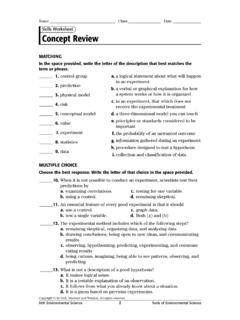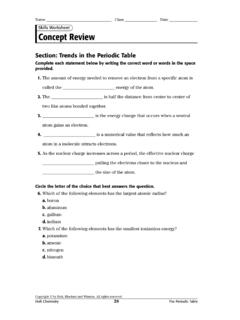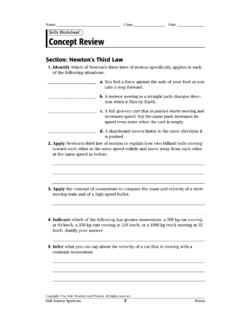Transcription of Skills Worksheet Concept Review - Marian High …
1 Copyright by Holt, Rinehart and Winston. All rights Chemistry6 StoichiometrySection: Limiting Reactants and Percentage YieldComplete each statement below by choosing a term from the following list. Terms may be used more than (n) reactant is not completely used up in a chemi-cal (n) reactant is used up first and thus controls the quantity of that can be formed in a reactant that runs out first is the reactant. limiting reactant should be used in calcula-tions to determine the maximum amount of product is a factor in selecting the reactant. industry, the least expensive reactant is usually used as the reactant. In this way, the more expensive reactantis completely used up, while some of the cheaper reactant is left yield is a way to describe reaction percentage yield describes how close the yieldis to the yield must be measured percentage yield figures can be used to predict what the yield will likely the following items in the space g of Mg is ignited in g of pure oxygen, what is the limitingreactant?
2 What is the theoretical yield of MgO?2Mg(s) O2(g) 2 MgO(s)NameClassDateConcept ReviewSkills WorksheetCopyright by Holt, Rinehart and Winston. All rights Chemistry7 StoichiometryNameClassDateConcept Review 32 g of O2reacts with 23 g of C2H5OH, what is the limiting reactant?What is the theoretical yield in grams of CO2?C2H5OH(l) 3O2(g) 2CO2(g) 3H2O(l) is the limiting reactant when 154 g of Ag reacts with 189 g of HNO3?What is the theoretical yield in grams of AgNO3?3Ag(s) 4 HNO3(aq) 3 AgNO3(aq) NO(g) 2H2O(l) student used g of silver to produce silver nitrate. The actual yield g. Calculate the percentage yield. 3Ag(s) 4 HNO3(aq) 3 AgNO3(aq) NO(g) 2H2O(l) prepare the paint pigment chrome yellow, PbCrO4, a student started g of Pb(NO3)2.
3 The actual yield of PbCrO4was g. Calculate thetheoretical yield and the percentage yield. Pb(NO3)2(aq) Na2 CrO4(aq) PbCrO4(s) 2 NaNO3(aq)Copyright by Holt, Rinehart and Winston. All rights Chemistry8 StoichiometryNameClassDateConcept Review the actual yield in grams of MgO when g of magnesium isburned in air. The percentage yield of the reaction is (s) O2(g) 2 MgO(s) the actual yield of Fe2O3when g of iron(II) sulfide is burnedin air. The percentage yield of the reaction is (s) 7O2(g) 2Fe2O3(s) 4SO2(g) the actual yield in grams of CCl4if g of Cl2reacts withmethane. The percentage yield of the reaction is (g) 4Cl2(g) CCl4(g) 4 HCl(g) Concept Review :Calculating Quantities s g Ca3(PO4)2 1 mol Ca3(PO4)2 g Ca3(PO4)2 2 mol P/1 mol Ca3(PO4)
4 2 g P/1 mol P g g Al 1 mol g Al 2 mol AlCl3/2 mol Al g AlCl3/1 mol AlCl3 89 g g C6H12O6 1 mol C6H12O6 g C6H12O6 2 mol C2H5OH/1 mol C6H12O6 g C2H5OH/1 mol C2H5OH 588 g g Mg 1 mol g Mg 1 mol O2/2 mol Mg mol mol C5H11OH 10 mol CO2/2 mol C5H11OH g CO2/1 mol CO2 220 g g CCl3NO2 1 molCCl3NO2 g CCl3NO2 1 molCH3NO2/1 mol CCl3NO2 mol g KClO3 1 mol KClO3 gKClO3 g O2/1 mol O2 3 molO2/2 mol KClO3 1 L O2 g O2 L L O2 g O2/1 L O2 1 molO2 g O2 2 mol KCl/3 mol O2 g KCl/1 mol KCl g g Ca3P2 1 mol Ca3P2 gCa3P2 2 mol PH3/1 mol Ca3P2 g PH3/1 mol PH3 1 LPH3 g PH3 220 L g P 1 mol g P 5 molO2/4 mol P g O2/1 mol O2 100. g air/23 g O2 520 g metric tons coke coke 106g/1 metricton g CO2/1 mol CO2 1 g C 1 mol CO2/1 mol C 1 metric 106g metrictons mL CS2 g CS2/1 mL CS2 1 mol CS2 g CS2 2 mol SO2/1mol CS2 L SO2/1 mol SO2 L L SO2 1 mol CO2/2mol SO2 L CO2 Concept Review : LimitingReactants and , ; g Mg (1 mol g Mg) mol g O2 (1 mol O2 g O2) mol mol O2 (2 mol Mg/1 mol O2) mol Mg is mol Mg (2 mol MgO/2 mol Mg) ( g MgO/1 mol MgO) gMgOCopyright by Holt, Rinehart and Winston.
5 All rights Chemistry86 StoichiometryAnswer KeyTEACHER RESOURCE g C2H5OH (1 mol C2H5 C2H5OH) mol C2H5OH32 g O2 (1 mol O2 g O2) mol O2 (1 mol C2H5OH/3 molO2) mol C2H5OH neededO2is mol O2 (2 mol CO2/3 mol O2) ( g CO2/1 mol CO2) 29 g g Ag (1 mol g Ag) mol Ag189 g HNO3 (1 mol HNO3 gHNO3) mol mol HNO3 (3 mol Ag/4 molHNO3) mol Ag neededAg is mol Ag (3 mol AgNO3/3 molAg) ( g AgNO3/1 mol AgNO3) 243 g g Ag (1 mol g Ag) (3 mol AgNO3/3 mol Ag) ( gAgNO3/1 mol AgNO3) g AgNO3percentage yield (actual yield/theo-retical yield) x 100( g AgNO3actual gAgNO3theoretical yield) 100 g Pb(NO3)2 (1 molPb(NO3)2 g Pb(NO3)2) (1 molPbCrO4/1 mol Pb(NO3)2) ( gPbCrO4/1 mol PbCrO4)percentage yield (actual yield/theo-retical yield) 100 ( gPbCrO4 g PbCrO4) 100 g Mg (1 mol g Mg) (2 mol MgO/2 mol Mg) ( gMgO/1 mol MgO) ( percentageyield/100% theoretical yield) g FeS (1 mol g FeS) (2 mol Fe2O3/4 mol FeS) ( Fe2O3/1 mol Fe2O3) g Fe2O3theoretical g Fe2O3 ( % percentageyield/100% theoretical yield) g Cl2 (1 mol Cl2 g Cl2) (1 mol CCl4/4 mol Cl2) ( gCCl4/1 mol CCl4) ( actualyield/100% theoretical yield) g CCl4 Concept Review .
6 Stoichiometry and there is too much oxygen and notenough gasoline, the engine will , on the other hand, gasoline is inexcess and there is not enough oxy-gen, lack of oxygen may prevent themixture from L N2 ( g N2/1 L N2) (1mol N2 g N2) (2 mol NaN3/3mol N2) ( g NaN3/1 mol NaN3) g mL C8H18 ( g C8H18/1 mLC8H18) (1 mol C8H18 gC8H18) (25 mol O2/2 mol C8H18) ( g O2/1 mol O2) (1 L O2 gO2) (100 g air/23 g O2) 103g g NO2 (1 mol NO2 g NO2) (1 mol O3/1 mol NO2) ( g O3/1 mol O3) g : ( L)( g/ml)(1000 ml/1 L) ( )(700 g) 1750 gMW octane L octane (1750 g)(1 ) L octane yields 8( mol) mol CO2MW CO2 g/mol( mol CO2)( g/mol) 5394 g CO2 Additional mol (NH4)2SO42. g g mol g 2 KOH K2SO4 2H2O; g H2SO45.
7 2NH3 (NH4) mol (NH4) kg NH36. mol ZnCO3; mol kg H2O; kg CO2 Copyright by Holt, Rinehart and Winston. All rights Chemistry87 StoichiometryTEACHER RESOURCE PAGE










